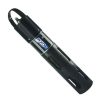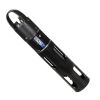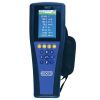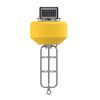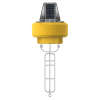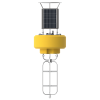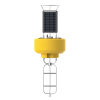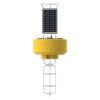YSI EXO1s Multi-Parameter Water Quality Sonde
Features
- Ideal for spot sampling or attachment to data buoys, AUV's, drones, etc.
- Smaller, lighter sondes can be deployed in tight spaces
- A more budget-friendly EXO without alkaline batteries
- Expedited repair and warranty service
- Lifetime technical support
- More
Overview
The YSI EXO represents the next generation of water quality instruments from YSI. The advanced sonde platform offers a wide range of capabilities to those dedicated to monitoring natural aquatic environments such as oceans, estuaries, rivers, lakes, and groundwater. With a highly efficient power management platform, robust construction, and chemistry-free anti-fouling system, EXO allows accurate data collection for up to 90 days between service intervals.
Parameters
The EXO1s sonde includes four sensor ports with internal data logging. Sensor parameters include temperature, conductivity, depth, dissolved oxygen, pH, ORP, total algae (phycocyanin or phycoerythrin along with chlorophyll), turbidity, fluorescent dissolved organic matter (fDOM), Rhodamine WT, UV nitrate, ISE ammonium, ISE nitrate, and ISE chloride. The sonde can also output four calculated parameters including salinity, specific conductance, total dissolved solids (TDS) and total suspended solids (TSS).
Mechanics
All EXO sensors are digital sensors with on-board signal processing and memory. Built-in sensor diagnostic and calibration data allows users to calibrate multiple sensors in one sonde and distribute to various other sondes in the field. Wet-mateable connectors allow for swaps in wet conditions, while active port monitoring automatically detects each sensor and verifies operation.
EXO1s Specifications
Diameter: 4.75cm (1.87 in)
Length (with guard): 44.77cm (17.63 in) without depth sensor; 46.41cm (18.27 in) with depth sensor
Peripheral Ports: 1 power communication port
Sensor Ports: 4
3-Year Warranty: Sonde; handheld
2-Year Warranty: Cables; conductivity/temperature and optical sensors; electronics base for pH, pH/ORP, ammonium, chloride, and nitrate sensors
1-Year Warranty: Optical DO cap and replaceable reagent modules for pH and pH/ORP sensors
3-Month Warranty: Replaceable reagent modules for ammonium, chloride, and nitrate sensors
Weight: 0.48kg (1.06 lbs) without depth sensor; 0.56kg (1.24 lbs) with depth sensor
General Sonde Specifications
Power Requirement: 9-16 VDC
Computer Interface: YSIP via USB Signal Output Adapter (SOA) and Bluetooth
Output Options: RS-232 & SDI-12 via DCP-SOA; Modbus & RS-485 via Modbus-SOA
Data Memory: 512 MB total memory; >1,000,000 Logged readings
Depth Rating: 0 to 250m (0 to 820 ft)
Sample Rate: Up to 4 Hz
Operating Temperature: -5 to +50°C (23 to 122°F)
Storage Temperature: -20 to +80°C (-4 to 176°F)
- (1) EXO1s sonde
- (1) Probe guard
- (1) Calibration cup
- (1) Tool kit
- (2) Port plugs
- (1) USB drive loaded with manual & Kor Software
In The News
Supplying Seattle’s Drinking Water: Using Data Buoys to Monitor the Cedar River Municipal Watershed
Providing clean, safe, and reliable drinking water for the 1.6 million people in the greater Seattle area is a top priority for Seattle Public Utilities (SPU). With limited water supplies, SPU dedicates considerable resources to maintain its watersheds and mountain reservoirs. About 70 percent of Seattle Water comes from the Cedar River Municipal Watershed , and the other 30 percent comes from the South Fork Tolt River Watershed . [caption id="attachment_39574" align="alignnone" width="940"] Data buoy in Chester Morse Lake . (Credit: Kevin Johnson / Seattle Public Utilities) [/caption] Jamie Thompson, a fisheries biologist at SPU, monitors aquatic ecosystems centered on fish listed under the U.S. Endangered Species Act (ESA).
Read MoreData-Driven Advocacy on the Lower Deschutes River
Like many freshwater environments, the Deschutes River in Oregon is under pressure from development, pollution, and climate change. Many rivers, streams and lakes in the Deschutes Basin do not meet Oregon water quality standards –where state water quality monitoring assesses levels of bacteria, pH, dissolved oxygen, temperature, and fine sediment. Hannah Camel is the Water Quality Coordinator for the Deschutes River Alliance (DRA), a non-profit organization that focuses on the health of the lower 100 miles of the Deschutes River–the area most affected by human intervention. As a data-driven organization, the DRA has benefited from the installation of two NexSens X2 data loggers.
Read MoreExpanding the Port Everglades: Real-Time Monitoring of Water Quality Conditions from Planned Dredging Operation
The Port Everglades in Broward County, Florida, serves large trade vessels and cruiseliners and incoming and outgoing recreational boaters. However, as cargo ships become larger, the port must expand. A dredging project led by the US Army Corps of Engineers will substantially deepen and widen the port's navigation channel to accommodate larger Panamax cargo ships and modern cruise liners. As a result of this project, a large amount of sediment will be displaced into the water column. This suspended sediment may settle outside of the project area, burying benthic organisms like corals, and possibly carrying harmful particulates to other regions. [caption id="attachment_39497" align="aligncenter" width="2560"] A CB-950 and CB-25 deployed on site at Port Everglades.
Read More















































